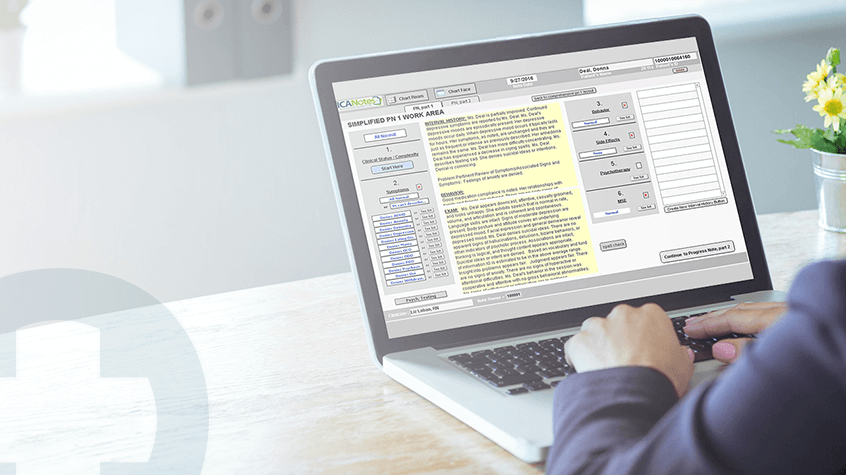
Best Practices for Behavioral Health Documentation
Mental health clinicians must complete many different types of behavioral health documentation during their clients' treatment. From intake to discharge, you must document each encounter with a patient fully and accurately. Behavioral health documentation has many uses, including providing diagnostic summaries, monitoring progress, keeping patient records up to date, and serving as a tool to facilitate communication between professionals and care teams.
Missing or incomplete information can lead to miscommunication, rejected or under-coded insurance claims, and overall frustration for everyone involved. Proper documentation of mental health services is also necessary for compliance with regulations and standards. This guide provides general best practices for documentation of behavioral health care and what you should and should not include in such notes.
Write Better, Write Faster
Get instant access to our Guide to Writing Efficient Clinical Notes in Behavioral Health
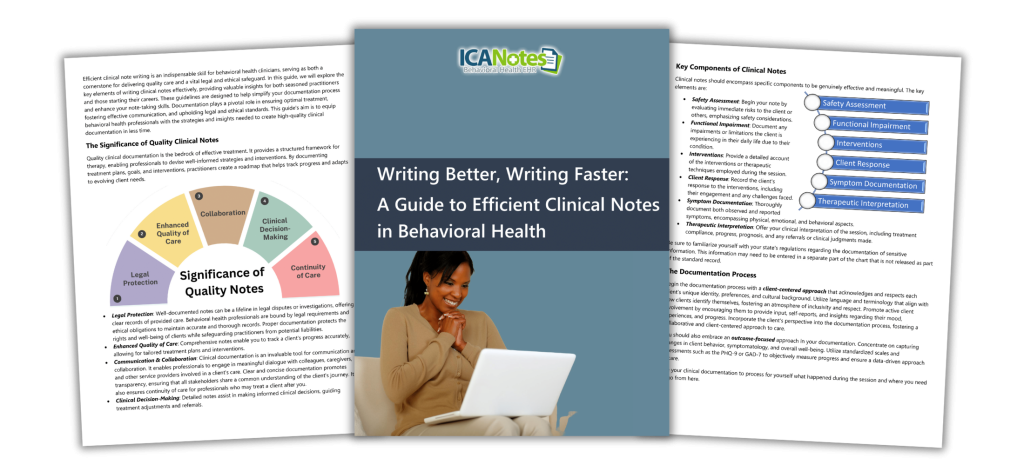
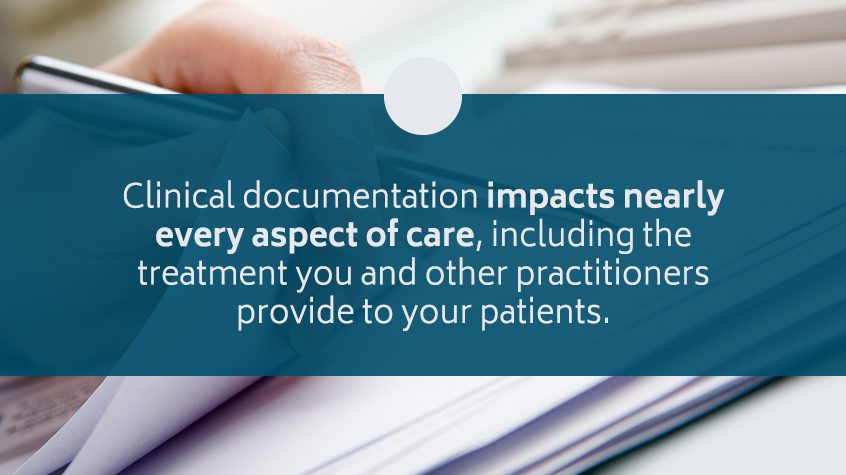
General Process for Mental Health Documentation —
Intake to Discharge
Clinical documentation impacts nearly every aspect of care, including the treatment you and other practitioners provide to your patients. Here's a summary of what various types of mental health documentation should include.
1. Intake and Assessment
To conduct a successful initial assessment with your patient, you should document their:
- Presenting problems
- Mental health status and history
- Previous treatments
- Current providers
- Relevant demographic information
- Medications
- Substance use information
- Physical or mental health conditions
2. Treatment Plans
Each patient's treatment plan should include their current diagnosis, goals and objectives, interventions and options, treatment modality and frequency, and methods for monitoring and measuring progress.
3. Ongoing Care
If a patient requires a referral or needs to transfer to another provider for any reason, you must thoroughly document this with informed consent to your patients. Also, describe whether you discussed the potential benefits and risks of the new behavioral health program or service.
4. Transferring Care
Behavioral health providers must keep accurate progress notes because they are essential for proper billing, reimbursement, and overall care. Other providers may use these notes to assist you with a patient's treatment plan. These notes should include demographic information, subjective and objective descriptions of client behavior, their symptoms, a summary of their diagnosis, what the client discussed in each session, your professional opinion, a treatment plan, and referrals if necessary.
5. Discharge Summaries
If you and your client feel you have completed their care, you'll need to document and sign a discharge summary. This form should include their diagnosis at discharge, detailed reasons for the discharge, progress toward treatment goals, potential risk factors at the time of discharge, and referrals or resources that could benefit the client.
The Do's and Don'ts of Clinical Documentation
Documentation facilitates communication among providers, promotes patient safety, minimizes errors, and improves the overall quality of patient care. As a result, these medical records must adhere to applicable regulations, professional practice standards, and legal requirements. Here are the dos and don'ts of behavioral health documentation.
What You Should Document
Though different types of behavioral health documentation and notes will have varying requirements, here are some general things you'll need to include in your patient's medical records:
- Thorough patient history
- Diagnosis and treatment details
- Consultations regarding prescribed medications
- Informed consent
- Treatment compliance/non-compliance
- Clinician signature and date on each entry
- Legible writing in permanent ink
- Patient ID or health record number on each page
- Test results and prior records
- Up-to-date entries as soon as the session ends
- Specific, factual, and objective language
- Patient engagement and response to treatment
- Approved abbreviations, acronyms, and symbols
- Entries that describe reasons for deviating from standard treatment, if needed
Behavioral health documentation is subject to more stringent confidentiality standards, so these records must remain private unless it's necessary and appropriate for other providers to review them. Be sure to exercise caution when transferring or filing patient records. To help improve security and maintain confidentiality and patient privacy, it's best to use an electronic system for your records so all providers can easily see modifications.
What You Shouldn't Document
Unless your documentation or the patient's overall care requires you to do otherwise, it's best to avoid the following actions in all types of clinical notes:
- Interpersonal conflicts
- Criminal behavior or history
- A detailed account of their sexuality
- Writing late entries
- Leaving blank areas on a page
- Erasing or blocking out previously entered information
- Deleting information
- Using subjective or speculative language
- Providing detailed accounts of events that are irrelevant to the patient's overall condition and treatment
- Including a diagnosis without symptoms
- Using flowery language
- Failing to include your full name, date, time, patient name, and patient identifier on every document
- Including quotes or identifying information about third parties unless essential
- Any details that clinical evidence and investigation cannot validate or justify
Documentation Requirements for
Insurance Reimbursements
All behavioral and mental health services must meet specific requirements for reimbursement. If your documentation does not accurately reflect the services and care you provided, it can result in an under-coded or denied claim from the insurance company. Here are a few FAQs about mental health billing and insurance claims.
1. What Do Insurance Companies Look for When Making Coverage Decisions?
Depending on your insurance company, if even the slightest detail is missing from your forms, it can result in a denied or rejected the claim. In addition to demographic information, such as the patient's name and birthdate, insurance companies need to see the following items:
- A thorough assessment of your patient's condition, including a mental health status exam
- Diagnosis justification explaining their symptoms
- A current overview of the problems you've addressed during treatment and how they relate to the diagnosis
- A clear, detailed, and time-sensitive treatment plan to help the client manage or overcome their condition
- All services you provided and your qualifications
- Progress notes to reflect consistent updates and monitoring of the client's condition or situation
2. Are Insurance Claim Rejections and Denials the Same Thing?
Insurance claim rejections are different from denials. Your clearinghouse or insurance company will reject your claim if it contains incorrect information, such as entering the wrong patient name or service code. Once the insurance company has identified an error, they will reject the claim instead of processing it as usual. Fortunately, you will likely receive an explanation of this rejection and which error caused it. From here, you can correct the issue and resubmit the claim with the correct information.
On the other hand, an insurance claim denial means your claim contained correct information, but the insurance company will not pay for the services you've billed them for. While you cannot resubmit denied claims, you can file an appeal. Your insurer should also explain this denial.
3. Why Did the Insurance Company Deny My Claim?
If your insurance company denied the claim and you haven't heard back with an explanation, here are some common causes of claim denials in the behavioral health field:
- Your handwritten progress notes or other documentation are illegible or difficult to comprehend.
- You provided more than one service in one day.
- You submitted duplicate claims.
- You missed the deadline for submission.
- Your services do not meet the insurance company's medical necessity requirements.
- Your client's plan does not cover the services you provided.
- You provided treatment or services without a referral or preauthorization.
- The authorization for your service expired.
- Your client no longer has insurance coverage.
4. How Can I Reduce Claim Denials?
Well-written, accurate and timely documentation is essential for maximizing your insurance reimbursements. However, let's look at some additional tips you can remember for reducing insurance claim denials in the mental health field.
- Code your claims correctly: As with all other aspects of your documentation, you must use the correct billing codes to avoid a rejected or denied insurance claim. For instance, any errors on your CMS 1500 claim form can result in a lower reimbursement rate or delayed payment.
- Verify your patient's insurance: Early verification is an effective way to prevent dealing with insurance issues down the line. Whether you have a new or existing client who has switched plans or carriers, verifying this information at every visit will help you code more cleanly and prevent frustration and lost time.
- Take robust and comprehensive therapy notes: Perhaps the most critical aspect of insurance reimbursement is providing your insurer with proper, thorough documentation, including your treatment methods and progress notes, if necessary. Keep your insurance company's requirements for medical necessities in mind when writing your notes to help you avoid a denial.
- File your claims on time: Getting your claims in before the deadline can prevent a claim denial or rejection. Submitting your claims early can reduce any issues.
- Adopt automated solutions: With a busy schedule, it can be challenging for you and other professionals in your practice to consistently avoid mistakes, especially when you rely on a manual or outdated process. Implementing an automated solution that integrates with a clearinghouse can help you stay organized, correct mistakes and keep your claims clean.
Other Mental Health Documentation Principles to Remember
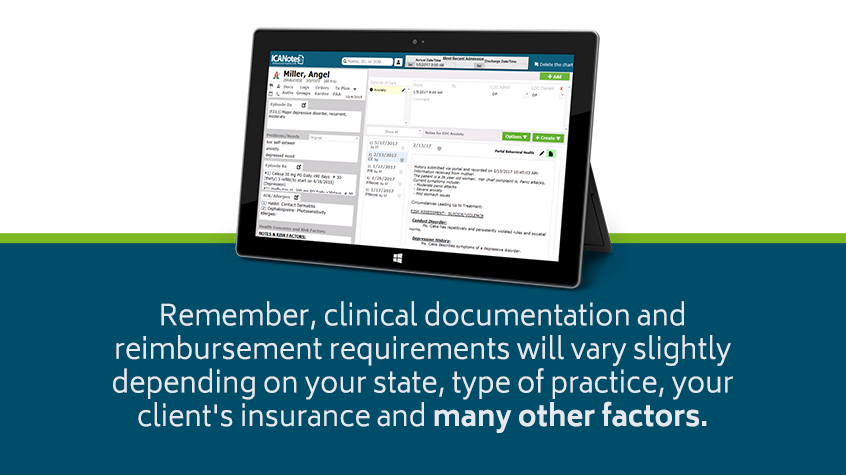
Remember, clinical documentation and reimbursement requirements will vary slightly depending on your state, type of practice, your client's insurance, and many other factors. Still, it's always best to brush up on some fundamental mental health documentation principles.
- Write for others: While psychotherapy notes should stay private, you can use progress notes, treatment plans, and other documentation to improve your care standards. Your notes and treatment plans should accurately reflect your progress. Likewise, all documents should include plainly written information with enough detail so other service providers can understand the client's needs and why you provided such services.
- Keep it consistent: Each note should have consistent clinical information and create a comprehensive story of the client's progress. For instance, if you fail to record notes for several sessions in a row, there is no way to prove that you provided any treatment or that your client has progressed in any way.
- Keep it confidential: Whether paper or electronic, these clinical notes are legal documents and should remain private. Avoid writing other clients' names on a patient's chart. If you're treating two patients who are relatives, refer to their relationship, such as mother, sister, husband, etc. Sometimes, you may use another person's initials for clarification but never use their full name.
- Correct entries: Always include the date and time on your documentation, even if you're updating patient history or life events, such as a marriage or change in address. If you ever need to correct the information on a clinical record, include your name and the time and date. Most practices avoid crossing out entries on paper, so it may be best to create a new entry and write “mistaken entry” to clarify your action. Always note the reason for the correction and make the edits on all paper or electronic records.
Common Behavioral Health Documentation Errors to Avoid
If you're not careful, behavioral health documentation can sometimes result in errors and mistakes when written by hand or on an outdated system. When dealing with patients, checking and double-checking yourself is critical to ensure your notes are up-to-date, complete, and accurate. Let's recap some of the most common documentation errors behavioral health professionals commit.
- Failing to add the date or time on the document
- Failing to sign the document
- Adding entries on a file after the original creation date
- Writing information in the wrong box, chart, or page
- Using vague language
- Documenting subjective information
- Failing to produce documentation for omitted medication or treatments
- Failing to use clear, legible handwriting
- Repeating information within the same document
- Failing to question incomprehensible information or orders
- Using incorrect or nonstandard abbreviations
- Including unsourced opinions
- Making general statements without supporting data
- Crossing out statements or making adjustments without rewriting
These issues can lead to mixed messages with insurance companies and other care providers looking to obtain a patient's behavioral health history. For example, sloppy handwriting may not seem like a problem at the moment, but if others cannot decipher your writing, it can affect the care you provide and even lead to medication errors.
In more severe cases, medical record and documentation errors may reflect poor clinical care, result in loss of revenue or reimbursement, demonstrate non-compliance, or support malpractice or fraud allegations.
Tips for Improving Behavioral Health Documentation
Because behavioral health and psychiatric documentation are critical components of the care you provide, you must reflect on ways to improve your current note-writing processes. If you want to revamp your documentation standards, consider implementing the following tips.
- Educate new staff members: Some behavioral health practices may assume that all new hires know the ins and outs of documentation standards. While many may have a general understanding, it's critical to provide structured clinical documentation training to new and existing staff members. You should update this with new regulations, compliance standards or general information needed for day-to-day patient documentation processes.
- Review, review, review: While this seems like an obvious tip, every behavioral health provider and professional should reassess their work before submitting or filing any documents. Taking a few minutes to ensure documents are accurate can prevent mistakes and downtime.
- Use note-writing templates for organization: Documents can be challenging to comprehend if they're disorganized or contain irrelevant information. A format like SOAP notes or BIRP notes streamlines the note-writing process for providers by giving them a set template to follow. These templates make it easy for practitioners to include all required information efficiently without adding unnecessary details.
- Implement EHR software: An electronic health record system provides the technical competencies practitioners need to support accurate, complete, legible, organized and compliant documentation. Some EHRs also contain many convenient features, such as billing, telehealth, and charting, that enable behavioral health professionals to spend less time documenting and more time with their patients.
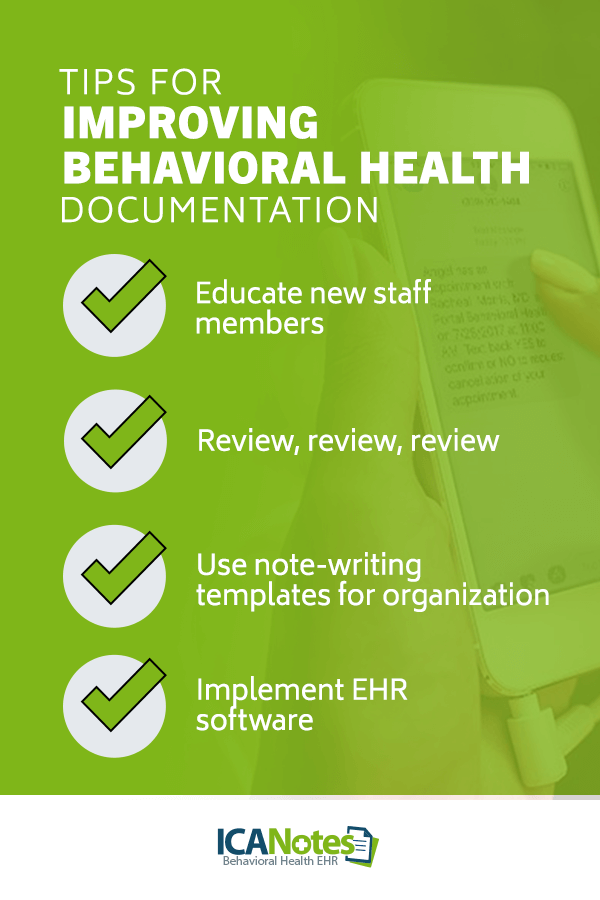
Experience Quick, Comprehensive and Sophisticated Behavioral Health Documentation With ICANotes EHR Software
Behavioral health documentation and note-writing come with many requirements. It can be challenging for providers like you to keep track of notes, organize them and ensure you fill everything out correctly and accurately for insurance reimbursements. In general, note-writing and documentation can be a headache. With EHR software from ICANotes, you can spend less time documenting and worrying about requirements and focus on spending more time with your patients.
At ICANotes, we know how difficult and time-consuming it can be to efficiently create sophisticated, comprehensive notes. That's why we developed an automated solution to help behavioral health practitioners improve clinical documentation's content and legibility. To learn more about the features we offer, schedule a demo, request a free trial online or contact us today for more information.

